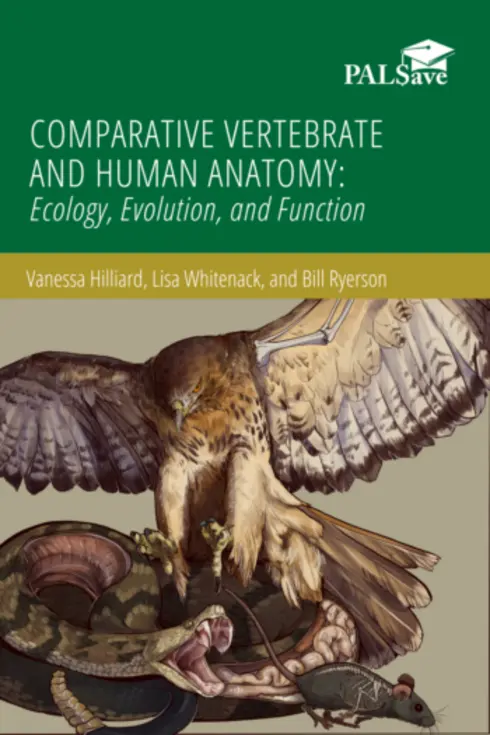
Comparative Vertebrate and Human Anatomy: Ecology, Evolution, and Function
No ratings
Vanessa K Hilliard, Saint Mary’s College
Lisa Whitenack, Allegheny College
Bill Ryerson, Cornell University
Amy Cheu, Portland Community College
Copyright Year:
Publisher: PALNI
Language: English
Formats Available
Conditions of Use
![]() Attribution
Attribution
CC BY
Table of Contents
- Introduction: History and Core Concepts
- The Nonvertebrate Chordates
- Vertebrate Origins
- Embryology
- Form and Function
- Integument
- Bone and Cartilage
- The Skull
- Postcranial Axial Skeleton
- Appendicular Skeleton
- Muscle Tissue
- Gross Muscle Anatomy
- Digestive System
- Respiratory System
- Circulatory System
- Urogenital System: Excretion
- Urogenital System: Reproduction
- Central Nervous System
- Peripheral Nervous System
- Nervous System: Sensory Organs
- Endocrine System
- Attributions
- Contributors
About the Book
This book provides an ecology- and function-oriented approach to understanding the evolution of vertebrate structure. The text has a modular format, such that each module can be used as a stand-alone instructional tool, or grouped together as a comprehensive textbook, making the text versatile for use in courses with diverse structures. The text also includes human-specific modules for each anatomical system, as many small, liberal arts colleges teach comparative and human anatomy in a single course. Detailed, human-specific modules may be added or removed, as needed for individual courses, depending on the scope and learning objectives of the class.
About the Contributors
Authors
Vanessa Hilliard is an Associate Professor of Biology and the director of the Ecuador Study Abroad Program at Saint Mary’s College in Notre Dame, IN. Her work broadly examines relationships between form and function, evolution, and ecology, with a particular emphasis on locomotor structures (limbs and tails). Other areas of scholarship include diversity and inclusion in STEM disciplines, the development of inclusive field safety plans, human kinematics and injury prevention, and population dynamics and conservation of yellow-footed tortoises in the Ecuadorian Amazon. At Saint Mary’s, Dr. Hilliard teaches Comparative Vertebrate and Human Anatomy, Human Anatomy and Physiology (Nursing), Biomechanics, Kinesiology, Foundations of Form and Function, and Environments of Ecuador. When not at work, Dr. Hilliard enjoys time outside (running, hiking, camping, gardening), baking and canning, live music, dancing, and quality time with the people she loves, especially her sons.
Lisa Whitenack is a Professor of Biology and the Director of Faculty Development at Allegheny College in Meadville, PA. Her scientific research investigates the evolution of morphology, especially the evolution and biomechanics of shark teeth across their 400 million-year evolutionary history. Dr. Whitenack’s other area of scholarship is in K-undergraduate STEM education, from pedagogy to DEIB and access. Comparative Vertebrate Anatomy is one of her favorite courses to teach. Outside of academics, Dr. Whitenack is a baker, musician, crafter, and parent to two science-loving, musically-inclined kiddos.
Bill Ryerson is a Senior Lecturer in Anatomy and Foundation Course Leader at Cornell University’s College of Veterinary Medicine. His research focuses on the functional morphology, behavior, and biomechanics of feeding in vertebrates, particularly reptiles. He also participates in scholarly work in veterinary education, particularly in the teaching of anatomy and physiology to students interested in human and animal medicine. He has taught Comparative Anatomy and Human Anatomy and Physiology at the undergraduate and professional school levels. Outside of the classroom Dr. Ryerson is bad at many things, but his favorites are wildlife photography, fishing, and riding his motorcycle.
Illustrator
Amy Cheu, Portland Community College
